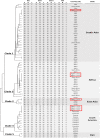Emergence of Candida auris in intensive care units in Algeria
- PMID: 35546294
- PMCID: PMC9328195
- DOI: 10.1111/myc.13470
Emergence of Candida auris in intensive care units in Algeria
Abstract
Background: Currently, Candida auris is among the most serious emerging pathogens that can be associated with nosocomial infections and outbreaks in intensive care units. Clinicians must be able to identify and manage it quickly.
Objective: Here, we report for the first time in Algeria seven cases of C. auris infection or colonisation.
Methods and results: The strains were isolated from clinical sites including bronchial aspirates (n = 4), wound swabs (n = 1), urine sample (n = 1) and peritoneal fluid (n = 1), in patients admitted to the intensive care unit. Candida auris was identified both by MALDI-TOF and by sequencing the ITS region and the D1/D2 domain. Antifungal susceptibility testing was performed using the E-test method. Non-wildtype susceptibility was observed for five strains against fluconazole, itraconazole, voriconazole and caspofungin. Genotyping showed the presence of four clades (I-IV) in one hospital.
Conclusions: Appropriate antifungal treatments with rapid and accurate microbial identification are the cornerstone for the management and control of C. auris infections.
Keywords: Candida auris; Algeria; ICU; clades (I-IV); emergence.
© 2022 The Authors. Mycoses published by Wiley-VCH GmbH.
Conflict of interest statement
The authors declare no conflict of interest.
Figures

References
-
- Satoh K, Makimura K, Hasumi Y, Nishiyama Y, Uchida K, Yamaguchi H. Candida auris sp. nov., a novel ascomycetous yeast isolated from the external ear canal of an inpatient in a Japanese hospital. Microbiol Immunol. 2009;53:41‐44. - PubMed
-
- Desnos‐Ollivier M, Fekkar A, Bretagne S. Earliest case of Candida auris infection imported in 2007 in Europe from India prior to the 2009 description in Japan. J Med Mycol. 2021;31(3):101139. - PubMed
-
- de Jong AW, Hagen F. Attack, defend and persist: how the fungal pathogen Candida auris was able to emerge globally in healthcare environments. Mycopathologia. 2019;184(3):353‐365. - PubMed
MeSH terms
Substances
Grants and funding
LinkOut - more resources
Full Text Sources
Medical

